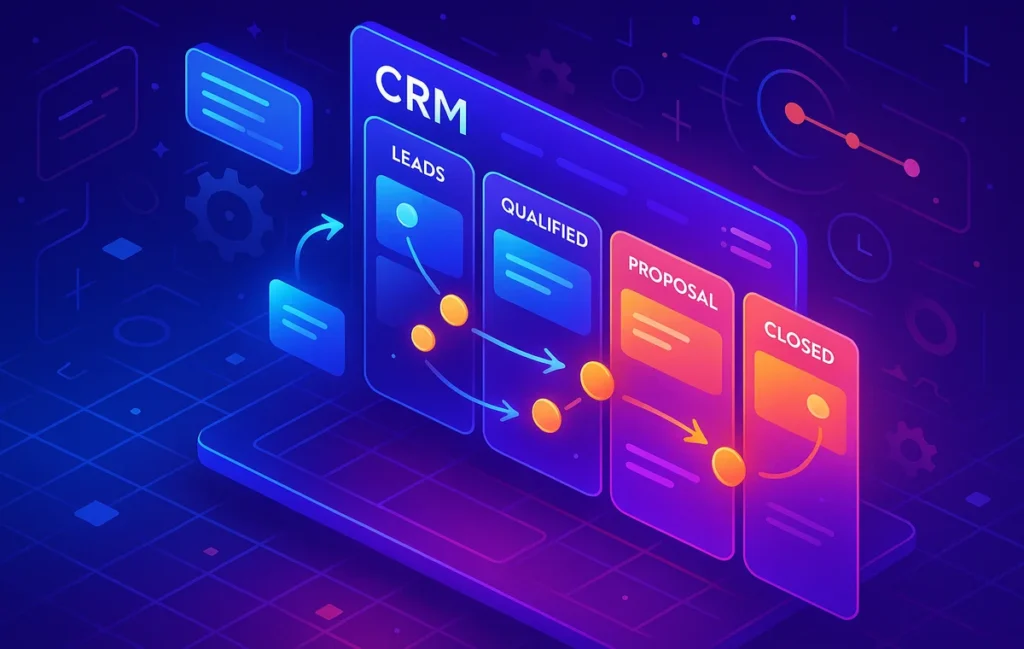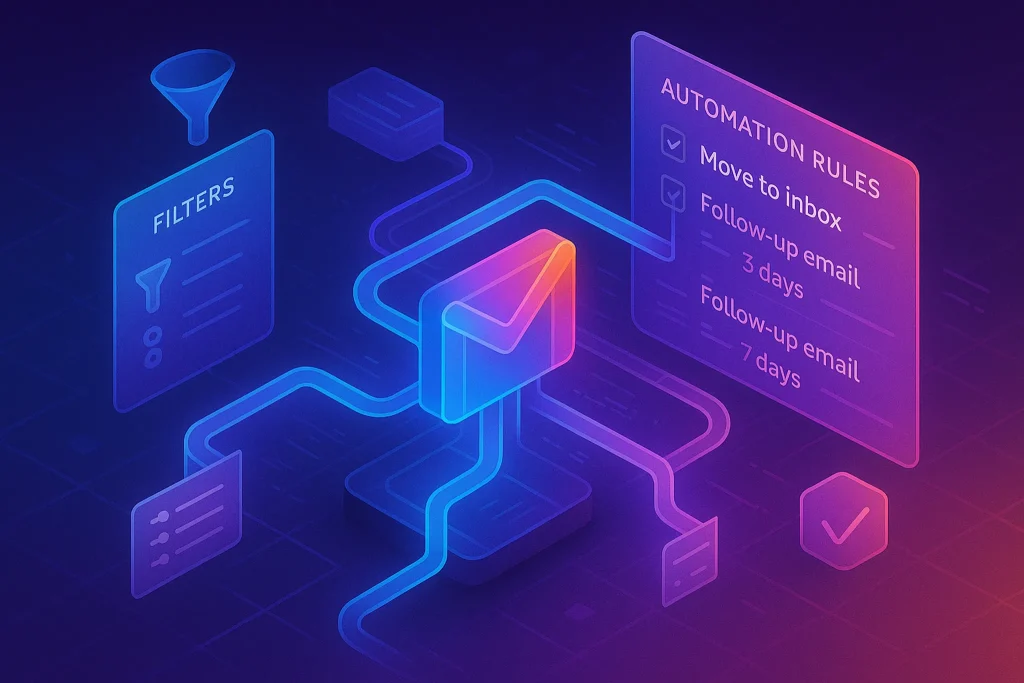🔑 Why CRM Setup Matters More Than the Tool
Many teams sign up for a shiny CRM only to abandon it weeks later. The reason isn’t usually the software—it’s the setup. A CRM is only as strong as the data structure and workflows you design inside it. Fields determine what you capture, pipelines organize how opportunities move, and automations free your team from repetitive tasks. In this guide, we’ll go deep into the three pillars of setup—Fields, Pipelines, and Automations—with practical examples from platforms like HubSpot, Zoho, and Pipedrive.
💡 Nerd Tip: Don’t chase “more features.” Chase alignment. The best CRM is the one that reflects how your business really works.
🗂️ Step 1: Designing CRM Fields That Actually Matter
Fields are the DNA of your CRM. They decide what data you collect and how usable it is later for segmenting, reporting, or automating. Too many businesses overload their system with 50+ fields, and reps stop entering data altogether. The sweet spot is balancing essentials with flexibility.
Think about a SaaS startup tracking inbound demo requests. Core fields like Name, Email, Company, Deal Value, Source, and Status are obvious. But a smart layer is adding “Urgency Level” or “Product Interest”. These are not vanity data points; they fuel automation rules and prioritization.
For example, in HubSpot CRM, a sales rep can instantly filter leads tagged with “High Urgency” to fast-track outreach. In Zoho CRM, you can create custom dropdowns for industry verticals—this makes reporting by niche effortless later. Pipedrive takes it a step further with activity-based fields, where you can log not only contact info but also behavioral triggers (e.g., “Last Email Opened”).
💡 Nerd Tip: Every new field should answer the question: Will this data change how we act? If not, skip it.
When done right, fields unlock better insights and marketing alignment. Imagine combining them with content marketing platforms—suddenly your CRM data can feed into campaigns that feel personalized, not generic.
📊 Step 2: Building Pipelines That Reflect Reality
A pipeline isn’t just a visual board—it’s a behavioral roadmap for your team. Without a clear pipeline, opportunities float in limbo, and forecasting becomes guesswork.
Take the example of a micro-business selling consulting packages. Their pipeline might look like this:
-
New Inquiry
-
Discovery Call Scheduled
-
Proposal Sent
-
Negotiation
-
Closed Won / Closed Lost
Notice how each stage represents an actual actionable checkpoint. You don’t want abstract stages like “Interested.” Instead, use verbs and milestones.
In Pipedrive, each stage can trigger prompts—for example, moving a deal to “Proposal Sent” could automatically remind you to follow up in three days. HubSpot takes pipelines further by letting you run multiple pipelines in parallel—great if you’re managing both inbound sales and partner deals.
💡 Nerd Tip: Don’t copy someone else’s pipeline blindly. Map your real-world process first, then build the digital version.
Here’s where internal alignment matters. If your CRM pipeline doesn’t match how marketing hands off leads, you’ll face friction. Teams that nail this integration often see 15–20% higher conversion rates because leads aren’t left waiting. If you’re not sure where to start, check our deep dive into Best Lightweight CRMs for Micro-Businesses to see pipeline templates optimized for small teams.
⚙️ Step 3: Automations—Your Always-On Assistant
Once your fields and pipelines are stable, automation is the accelerator. This is where CRM transforms from a passive database into an active teammate.
Imagine a lead fills out your site form for a free trial. Instead of manually logging them, your CRM should:
-
Create a new contact with all form fields mapped.
-
Assign the lead to a sales rep based on territory.
-
Trigger a personalized welcome email.
-
Set a task for the rep to follow up in 24 hours.
That’s not futuristic—it’s what even free versions of HubSpot can handle today. Zoho CRM adds workflow automation where you can score leads in real time based on actions (e.g., opening three emails in a week = +20 points). Pipedrive integrates with Slack or email to notify the team instantly when a hot lead advances stages.
💡 Nerd Tip: Start small. Automate one repetitive task per week, and within a month you’ll feel the time savings.
Automations also reduce human error. According to Salesforce data, businesses using CRM automation report 30% faster deal cycles. And when paired with marketing tools, automation ensures your sales team spends less time chasing and more time closing. To understand the line between sales and marketing workflows, read our comparison of CRM vs. Marketing Automation.
📘 Want the Full CRM Setup Checklist?
Subscribe to our free newsletter and instantly get the CRM Setup Checklist (PDF) — 10 must-have steps to build smarter pipelines, cleaner data, and automated workflows.
🔐 100% privacy. No spam. Just actionable CRM & automation tips from NerdChips every week.
🔒 Data Hygiene & Governance in CRMs
One of the most underestimated aspects of CRM setup is data hygiene. Without clear rules, your CRM quickly turns into a messy warehouse of duplicate contacts, empty fields, and outdated information. The danger here is subtle: you think you’re running reports on a healthy dataset, but in reality, half the numbers are inflated or inaccurate.
A clean CRM requires three layers of governance. First is deduplication, where tools like HubSpot’s duplicate management or Zoho’s data enrichment prevent multiple entries for the same contact. Second is validation rules—for instance, enforcing proper email formats or requiring a company name before saving a record. Third is ownership discipline. Every record should have a clear owner who is responsible for keeping it updated.
💡 Nerd Tip: Treat your CRM like a living organism. If you don’t regularly clean and feed it, it starts decaying quietly in the background.
A SaaS startup once reported losing over $50,000 in potential revenue because duplicate records split communications between two sales reps. One prospect got spammed with calls, the other was ignored completely. Data hygiene isn’t bureaucracy—it’s revenue protection.
📈 Reporting & Dashboards
The end goal of a CRM isn’t just to store data—it’s to generate insights that shape decisions. Well-designed dashboards turn thousands of small interactions into a clear business story.
Let’s say your pipeline has five stages. A reporting dashboard can instantly show that 40% of deals drop at the “Proposal Sent” stage. This tells you more training or better templates may be needed for that phase. Another report might show that leads from LinkedIn convert 3x better than those from cold email campaigns. These aren’t just numbers; they’re levers for growth.
HubSpot, for example, allows custom dashboards where sales velocity (average days per stage) is visible at a glance. Zoho CRM offers cohort analysis to track how different segments perform over time. Pipedrive’s reporting excels in stage-by-stage conversion visualization.
💡 Nerd Tip: Don’t drown in metrics. Choose 3–5 KPIs that directly connect to revenue, like lead-to-customer conversion rate or average deal cycle time.
Strong dashboards make your CRM more than a database—they turn it into a navigation system for your business strategy.
⚡ Ready to Build Smarter Workflows?
Explore CRM platforms like HubSpot, Zoho, and Pipedrive with built-in automations. Start shaping pipelines that close faster—without adding complexity.
🔗 Integrations with the Bigger Stack
No CRM should operate as an island. The real value comes when it becomes the central nervous system of your tech stack.
For example, integrating a CRM with your lead generation software ensures new prospects automatically appear in your database with enriched data. Instead of manually importing spreadsheets, the flow is seamless. Connect it with content marketing platforms, and suddenly your campaigns are targeted based on CRM fields like “Industry” or “Product Interest.” Sync it with accounting software, and invoices can be tracked alongside deals, giving finance and sales a unified picture.
Consider a marketing team running a campaign with gated content. Without integration, sales gets a CSV file once a week. With integration, every download instantly creates a CRM contact, tagged with the content they consumed. This means the sales rep starts the conversation already knowing what the lead cares about.
💡 Nerd Tip: Map integrations carefully. A poorly planned sync can flood your CRM with junk data, while a smart integration can boost conversions overnight.
This is also where automation platforms like Zapier or native APIs expand possibilities—linking CRMs to chatbots, customer support desks, or even AI-driven lead scoring engines.
👥 Adoption & Training
Even the most sophisticated CRM fails if your team doesn’t use it consistently. Adoption is not a side project—it’s the heartbeat of your CRM success.
Start by explaining the “why.” If reps believe the CRM is just surveillance for management, they’ll resist. But if they see it as a tool that makes their job easier, adoption skyrockets. Highlight how logging notes means they’ll never forget a follow-up or how dashboards make their targets more achievable.
Training should go beyond the technical. Instead of just “click here to add a deal,” show real use cases: “Here’s how a well-updated record helped us close a $20k client.” Micro-trainings, 10–15 minutes long, work better than one-off workshops. And SOPs (standard operating procedures) give everyone clarity on when and how to update the CRM.
💡 Nerd Tip: Make CRM usage part of the daily rhythm. For example, in sales stand-ups, review pipeline stages directly inside the CRM rather than in a separate spreadsheet.
A global study by CSO Insights showed that companies with strong CRM adoption achieve 14.6% higher win rates. The reason is simple—when everyone contributes to the system, the data reflects reality, and leaders can act decisively.
📬 Want More Smart AI Tips Like This?
Join our free newsletter and get weekly insights on CRMs, automation tools, and workflow design—delivered straight to your inbox. No fluff, just actionable guides for teams and creators.
🔐 100% privacy. No noise. Just value-packed insights from NerdChips.
🧠 Nerd Verdict
Setting up a CRM is not about clicking “Next” on onboarding screens—it’s about translating your unique sales DNA into digital form. Fields give you clarity on what matters, pipelines bring structure to your process, and automations multiply your team’s efficiency. The brands that invest in thoughtful CRM setup early often scale faster because they avoid chaotic data and leaky funnels. Whether you’re a solopreneur or a growing team, think of your CRM as the cockpit of your business. Configure it well, and every decision downstream becomes sharper.
❓ FAQ: Nerds Ask, We Answer
💬 Would You Bite?
How would you design your first CRM pipeline—lean and simple, or detailed and complex?
Share your take, and let’s see how different teams shape their workflows. 👇
Crafted by NerdChips to help teams turn messy data into streamlined growth machines.



